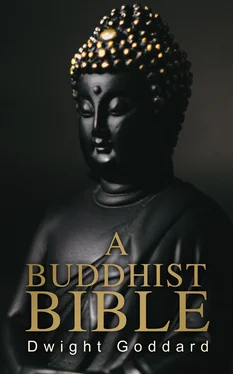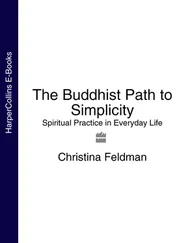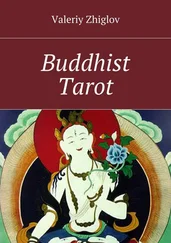Moreover there was the Taoist doctrine of Wu-wei. Wu-wei can be translated, "non-assertion." In Taoism it generally carries the meaning of the acceptance of Tao as being infinitely wise and beneficent and powerful, and therefore Taoism emphasises the futility of Interfering with the cosmic currents, and the wisdom of falling in with the natural unfoldment of the Tao in both nature and human affairs. To Taoists, the human interference either by force or legislation or culture with the course of nature is looked upon as the height of foolishness. To take things as they are and as they come is the teaching of Taoist wisdom. In one sense this is what Buddhism by its doctrine of "patient acceptance" teaches, but in another sense, Buddhism is quite opposed to any lazy inertness in meeting the difficulties of life. While Buddhism teaches the patient acceptance of the results of old karma, it also teaches that good karma is to be attained by the disciplined restrain of desire, habits of clear thinking, the extinction of egoism, and concentrated meditation, thus making a rational interference with the course of nature which if yielded to would result in suffering, the course of wisdom.
Another circumstance that tended undoubtedly to the yielding of Buddhism to Taoist influences in these early days was to escape the virulence of the nationalistic persecutions which were fomented by Confucianists and which for two hundred years were directed against all forms of Buddhism as being a foreign religion prejudicial to the welfare of the state. This persecution was largely escaped as Buddhism became disguised as a form of Taoism. And often it was not so much a disguise as it was the real thing. For instance, in the case of Hsuanchien who is usually reckoned as a Ch’an Buddhist of a rather extreme type, he is reported to have said to his disciples:
"Here there is no Buddha, nor Patriarch. Bodhidharma was only an old bearded barbarian. The Bodhisattvas are only dung-heap coolies. Nirvana and bodhi are dead stumps to tie your donkey to. The twelve divisions of the Tripitika are only lists of ghosts and sheets of paper fit only to wipe the puss from your skin. And all your four merits and ten stages are mere ghosts lingering in their decaying graves. Can these have any thing to do with your salvation?"
Of course such words as these must not be taken too literally for the literature of Ch’an Buddhism abounds with the most extravagant and seemingly foolish remarks of the Masters that to be understood and make sense of must be considered intuitively rather than logically. But they all go to show how serious and deep was the reaction between Buddhism and Taoism in those early centuries. At this distance of time it is hard to realise how difficult was the process toward adjustment between these two cults that had so much that was similar. For a century it was a question whether the result would be Taoism as modified by Buddhism, or Buddhism modified by Taoism. Most fortunately it proved to be the latter. Even down to day Taoist temples and Taoist monks are often indistinguishable from Buddhist temples. In 1927 the writer visited a Taoist friend at his hermitage-temple just outside of Nanking; it was arranged and decorated precisely like a Buddhist temple, had a Buddhist image of Amida, but when we left, the Taoist monk gave us as a parting gift, a copy of Laotsu's Tao Teh King. In Henri Borel's well known essays 1dealing with Laotzu's philosophy, his Taoist monk gives to his parting guest a beautiful image of Kwanon and in the essays themselves it is hard to say whether they are more Taoist or Buddhist.
Dr. Hu-shih, the eminent Chinese philosopher and. historian in a tentative and as yet unpublished study of this very subject and period, speaks of this reaction as "a revolt of Taoism against Buddhism"; while Dr. Daisetz Suzuki, the equally eminent authority of Zen Buddhism, speaks of it as the natural evolution of Buddhism under Taoist conditions. Of the two it would seem as though Dr. Suzuki was the nearer right, but in either case the result was the same: the development of a type of Buddhism that was free from the extravagancies of Indian philosophising and intellectual inertia and sentimental personalisations, and true to the original commonsense practicality of Shakyamuni.
By the Fourth Century most of the outstanding Mahayana scriptures had been translated into Chinese. Among them were many books about the Indian yoga practices of breathing and other methods for the attainment of mind-control and concentrated meditation, that made up the Indian practice of Dhyana. The Chinese were a practically minded people and had never cared very much for philosophy and metaphysics; being intellectual they were amazed and excited by the elaborate metaphysics and exuberant literature of the Mahayana, but they were more particularly attracted to the practical systems of dhyana that promised tangible results of enlightenment and ecstasy and blissful peace that could be tested and evaluated. It naturally came about, therefore, that the first serious popular acceptance of Buddhism was in the practice of Dhyana, and as the most popular subject for meditation and concentration was the Divine Name, with its promise of re-birth in the Pure Land, the later sects that go under that name, on the surface, appear to have a certain claim to priority. But it is a question whether this earliest acceptance can rightly be called a "salvation by faith" type of Buddhism, for its emphasis on dhyana practice would mark it as a "meditation" type. Much depends on whether the phrase, "Na-moo-mit-t’o-fu" was used in those early days as a subject for meditation and concentration, or as a mantra with magic working powers. Dr. Suzuki has discussed this question at length in his Essays in Zen Buddhism, Second Series, where it can be studied to advantage.
The first name that emerges in this connection is Tao-an ( -385). He was a notable monk, learned in both Confucian and Taoist lore and books of his are still extant dealing with these yoga practices of dhyana and commenting upon them. It is easy to see from them that he looked upon these Indian practices as good working methods for attaining Taoist ideals of non-activity and non-desire.
Tao-an left a disciple, Hui-yuan (333-416), who was also a great scholar and learned in Taoist mysticism. He is most remembered as the founder of a Buddhist center or fraternity near Kuling, known as the White Lotus Society, whose characteristic was their concentration on the Divine Name, in consequence of which he is commonly looked upon as the founder of the Pure Land Sects of China and Japan. But history shows that he was more interested in the serious practise of dhyana and to him the repetition of the Divine Name was the best method for attaining concentration of mind. There was nothing new in the practice of dhyana; it had existed in India for a millennium and was taken over by Shakyamuni and given a new content of meaning as the Eighth Stage of his Noble Path. As it appeared in China it was at first largely a practise of Indian yoga methods as an aid to meditation but it had degenerated into a popular and easy going "still-sitting" and a lazy habit of thinking. The characteristic that now began to emerge in the teachings and interest of Tao-an and Hui-yuan was the more definite focussing of mind and its more energetic character.
After Hui-yuan there came into prominence one of his disciples, Tao-seng ( -434), who with his disciple, Tao-you, developed the doctrine of "Sudden Awakening," as against the almost universal belief in the "Gradual Attainment," that thereafter entered into Chinese Buddhism to condition its distinctive characteristic. By this teaching the old conception of the gradual attainment of Buddhahood through myriads of kotis of re-births was challenged and in its place was offered, through the right concentration of dhyana, the possibility of sudden and perfect enlightenment. The Chinese Ch’an Buddhism that came to monopolise the religious field was the mingling of these two distinctively Chinese elements: A more strenuous dhyana, and the possibility of a sudden awakening and attainment of enlightenment, with the Indian philosophy of the Mahayana.
Читать дальше












